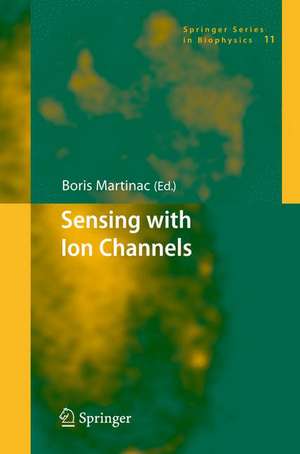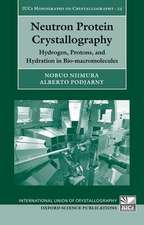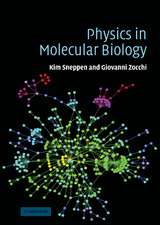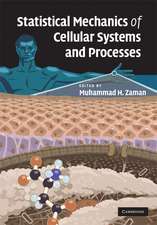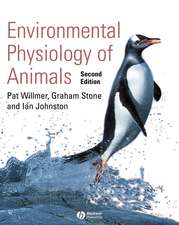Sensing with Ion Channels: Springer Series in Biophysics, cartea 11
Editat de Boris Martinacen Limba Engleză Hardback – 30 oct 2007
| Toate formatele și edițiile | Preț | Express |
|---|---|---|
| Paperback (1) | 946.24 lei 6-8 săpt. | |
| Springer Berlin, Heidelberg – 23 aug 2016 | 946.24 lei 6-8 săpt. | |
| Hardback (1) | 952.26 lei 6-8 săpt. | |
| Springer Berlin, Heidelberg – 30 oct 2007 | 952.26 lei 6-8 săpt. |
Din seria Springer Series in Biophysics
- 18%
 Preț: 961.72 lei
Preț: 961.72 lei - 18%
 Preț: 893.84 lei
Preț: 893.84 lei - 18%
 Preț: 958.07 lei
Preț: 958.07 lei - 20%
 Preț: 552.25 lei
Preț: 552.25 lei - 18%
 Preț: 1117.82 lei
Preț: 1117.82 lei - 15%
 Preț: 643.99 lei
Preț: 643.99 lei - 24%
 Preț: 1046.75 lei
Preț: 1046.75 lei - 18%
 Preț: 1226.24 lei
Preț: 1226.24 lei - 18%
 Preț: 1230.66 lei
Preț: 1230.66 lei - 18%
 Preț: 938.66 lei
Preț: 938.66 lei - 20%
 Preț: 551.88 lei
Preț: 551.88 lei - 18%
 Preț: 953.65 lei
Preț: 953.65 lei - 18%
 Preț: 948.16 lei
Preț: 948.16 lei - 15%
 Preț: 645.60 lei
Preț: 645.60 lei - 18%
 Preț: 723.38 lei
Preț: 723.38 lei - 18%
 Preț: 1146.56 lei
Preț: 1146.56 lei - 24%
 Preț: 686.63 lei
Preț: 686.63 lei - 20%
 Preț: 569.86 lei
Preț: 569.86 lei - 15%
 Preț: 642.51 lei
Preț: 642.51 lei - 15%
 Preț: 644.49 lei
Preț: 644.49 lei - 15%
 Preț: 649.71 lei
Preț: 649.71 lei - 15%
 Preț: 639.59 lei
Preț: 639.59 lei - 18%
 Preț: 951.29 lei
Preț: 951.29 lei - 15%
 Preț: 639.25 lei
Preț: 639.25 lei - 9%
 Preț: 872.36 lei
Preț: 872.36 lei
Preț: 952.26 lei
Preț vechi: 1161.29 lei
-18% Nou
Puncte Express: 1428
Preț estimativ în valută:
182.27€ • 198.06$ • 153.21£
182.27€ • 198.06$ • 153.21£
Carte tipărită la comandă
Livrare economică 21 aprilie-05 mai
Preluare comenzi: 021 569.72.76
Specificații
ISBN-13: 9783540726838
ISBN-10: 3540726837
Pagini: 317
Ilustrații: XXIII, 304 p.
Dimensiuni: 155 x 235 x 22 mm
Greutate: 0.64 kg
Ediția:2008
Editura: Springer Berlin, Heidelberg
Colecția Springer
Seria Springer Series in Biophysics
Locul publicării:Berlin, Heidelberg, Germany
ISBN-10: 3540726837
Pagini: 317
Ilustrații: XXIII, 304 p.
Dimensiuni: 155 x 235 x 22 mm
Greutate: 0.64 kg
Ediția:2008
Editura: Springer Berlin, Heidelberg
Colecția Springer
Seria Springer Series in Biophysics
Locul publicării:Berlin, Heidelberg, Germany
Public țintă
ResearchCuprins
Microbial Senses and Ion Channels.- Mechanosensitive Channels and Sensing Osmotic Stimuli in Bacteria.- Roles of Ion Channels in the Environmental Responses of Plants.- Ion Channels, Cell Volume, Cell Proliferation and Apoptotic Cell Death.- TRPV Ion Channels and Sensory Transduction of Osmotic and Mechanical Stimuli in Mammals.- Mechanisms of Thermosensation in TRP Channels.- TRPC Family of Ion Channels and Mechanotransduction.- Mechano- and Chemo-Sensory Polycystins.- Biophysics of CNG Ion Channels.- Sensory Transduction in Caenorhabditis elegans.- Epithelial Sodium and Acid-Sensing Ion Channels.- P2X3 Receptors and Sensory Transduction.- Voltage-Gated Calcium Channels in Nociception.
Notă biografică
Boris Martinac graduated in Physics from the Rheinish-Westphalian Technical University in Aachen, Germany in 1976 and received his PhD in Biophysics from the same university in 1980. His doctoral research on ion flux measurements across the cell membrane of a ciliate Paramecium was supervised by Eilo Hildebrand at the Research Centre Jülich. He then did postdoctoral work on electrophysiology of ciliates with Hans Machemer at the Ruhr University in Bochum. From there he moved in 1983 to the laboratory of Ching Kung at the University of Wisconsin, Madison where he used the patch clamp technique to study microbial ion channels. In 1993, he accepted a faculty position in the Department of Pharmacology at the University of Western Australia. In 2005, he moved to the School of Biomedical Sciences at the University of Queensland, Australia where he is a Foundation Professor of Biophysics.
Boris Martinac has earned international reputation as one of the pioneers in characterisation of ion channels in microbial cells. The discovery, cloning and structural and functional characterisation of mechanosensitive ion channels in bacteria present his original contribution to the ion channel research field. He is the recipient of a Fellowship by the French Ministry of Research and Higher Education and an Australian Professorial Fellowship by the Australian Research Council. He served as a President of the Australian Society for Biophysics, and has also served as a member of the Advisory Board of the European Biophysics Journal and as a Corresponding Member for Australia and New Zealand to the Physiological Reviews Editorial Board.
Boris Martinac has earned international reputation as one of the pioneers in characterisation of ion channels in microbial cells. The discovery, cloning and structural and functional characterisation of mechanosensitive ion channels in bacteria present his original contribution to the ion channel research field. He is the recipient of a Fellowship by the French Ministry of Research and Higher Education and an Australian Professorial Fellowship by the Australian Research Council. He served as a President of the Australian Society for Biophysics, and has also served as a member of the Advisory Board of the European Biophysics Journal and as a Corresponding Member for Australia and New Zealand to the Physiological Reviews Editorial Board.
Textul de pe ultima copertă
All living cells are able to detect and translate environmental stimuli into biologically meaningful signals. Sensations of touch, hearing, sight, taste, smell or pain are essential to the survival of all living organisms. The importance of sensory input for the existence of life thus justifies the effort made to understand its molecular origins. Sensing with Ion Channels focuses on ion channels as key molecules enabling biological systems to sense and process the physical and chemical stimuli that act upon cells in their living environment. Its aim is to serve as a reference to ion channel specialists and as a source of new information to non specialists who want to learn about the structural and functional diversity of ion channels and their role in sensory physiology.
Caracteristici
First book which is not exclusively focused on ion channels functioning in sensory mechanisms that are characteristic of animals and humans, but also describes the role of ion channels in signal transduction mechanisms found in microbial cells and plants Summarizes comprehensively the progress that has been made in studies of ion channels and their role in sensory physiology Addressing a great variety of sensory mechanisms found in all known types of living cells Includes supplementary material: sn.pub/extras
